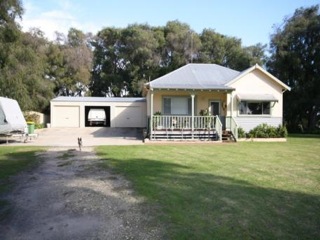Runnymede Farm
Host: BMC Consulting
Written by Blythe Calnan – Consultant, BMC Consulting.
If your dreams don’t scare you, they’re not big enough.
Many people dream of a life on their own property, working their own cattle, and making their own plans. For much of my life I have worked on properties and with other’s animals, gaining skills, and having amazing experiences. But there comes a time when you want your own verandah to rest your boots on and hang up your hat. Gregg and I had to downscale the million acres and 40,000 head dream, with Gregg’s kids at boarding school in Perth, our travel for work, and the budget available we ended up looking within a 300km radius of Perth for something which we could make some income with but support with our contracting.
An issue which has raised it’s head on both years I have sat with Cattle Council’s Rising Champions is how the youth get a start, and damn straight its hard. Even with a property owned outright for equity and a decent handful of cash, our inconsistent income as contractors, equity ratios, interest rates, and terms for rural loans made the going tough and the outlook bleak. Using all our equity and cash we might secure a property but would then have nothing left to stock it and establish ourselves!
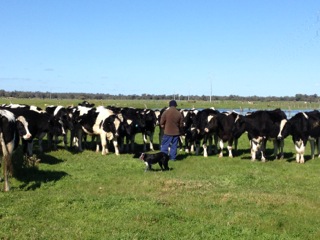 Getting acquainted with the locals, the first cattle I’ve ever owned!
Getting acquainted with the locals, the first cattle I’ve ever owned!
When we found ‘Runnymede’ in the South West it felt pretty good – 100 acres, an hour and a half from the airport with lush pastures, good house and facilities and an irrigation license. The asking price was still way out of reach for us but it had been on the market for a while so we offered what we could afford and to everyone’s surprise it was accepted. The scramble for finance was now on in earnest! With our ducks magically falling in a row, due to the size of the block Commonwealth offered to take us on as a home loan, totally changing the structure, equity requirements, and interest options. Suddenly we had a home, a good starter block, and some cash leftover to get us started.
After negotiating a deal with the outgoing owners we started with their half a house of furniture, an old tractor, 47 head of Fresian steers, and a shed full of half useful junk. The first four months are a blur of fencing, international trips, mortgage repayments, and finding out what we do and don’t have and know! The rain started coming down and cattle prices started going up, boding well for our little mob of Fresians as they went ahead on winter pasture and carrots from the next door neighbours, but offering us a challenge for restocking.
 Raising Boer goats has been a new challenge and a learning curve!
Raising Boer goats has been a new challenge and a learning curve!
With un-joined 18 month old black heifers selling for $1200 dollars a pop at local sales, that wasn’t how we were going to get the farm to help pay for our mortgage. With Gregg and my background and contacts in pastoral cattle, a knowledge of local and global markets, and a hunch we decided to take a gamble and bring pastoral shorthorn cross cull cows down to finish in the SW.
Since we were still figuring out what we were doing we initially decided on two decks, about 40 head. Somehow between enquires, negotiations, mustering, and contracts we ended up with 167 cows and 60 odd calves heading for our block and a few sleepless nights. At the time we gave the go ahead we had not a single yard or paddock suitable for pastoral cattle who were unlikely to know much about fences! Touching down from a month overseas, we launched into yard building, fencing, sourcing agistment blocks, and trying to figure out what the heck we were doing. Our local Elders guys helped us out enormously dropping around a seemingly endless list of gear from drenches to calf milk to new nipples in preparation for their arrival. Friends turned up with wellie boots and sausage rolls to help out in preparations and hay was sourced from all over the place to help them adjust.
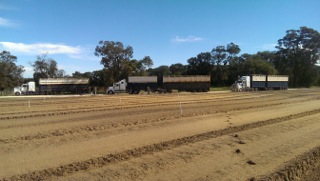 Biting off as much as we can chew, the girls arrive from the Pilbara.
Biting off as much as we can chew, the girls arrive from the Pilbara.
The agents and stockmen did a great job of ensuring only cows fit to load were put on the truck, Wardies truckies did an amazing job ensuring they all got down safely, watching the truckies tenderly carry off a few smaller calves and put them down to find their mothers was oh so sweet. After resting and having feed for the day at Muchea they loaded back up onto trucks and headed for greener pastures.
Unloading at Runnymede was fairly uneventful, despite one truck taking a wrong turn and ending up in a sand pit. All of a sudden the trucks were rolling off and we were on our own with a pretty wild looking bunch of ladies. They spent the next few days in the yards getting fed hay and learning from the Fresians how to eat carrots. Over the weekend we had the wildest weather we’ve had all year, welcome to the south west!
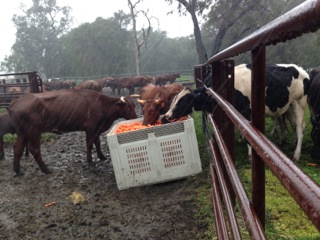 Welcome to the South West as the Fresians teach them how to eat carrots.
Welcome to the South West as the Fresians teach them how to eat carrots.
Letting them out into the cooler paddock was a nervous morning, Gregg was away servicing machines in the Pilbara and I was home alone but the yards were a muddy mess and the cattle were looking miserable. I drafted off the quietest 20 cows, saddled up a horse and double checked the electrics, with trepidation I opened the gate and heads whipped around to watch me, they followed the horse out of the yards, with me poised to launch into action to block them from charging down the paddock, however they reached the first blades of green grass and were heads down bums up from then on. Slowly releasing yard after yard into the cooler not a single animal challenged the fences or looked like trouble. What a relief!
When the rest of the team arrived home the next weekend the cows were brought in from the cooler, given a 7-in-1 vaccination to protect them from pulpy kidney disease, tetanus, black disease, malignant oedema, blackleg, and leptospirosis, a vitamin and mineral boost, worming drench, and the calves said good bye to their testicles. A job that would have taken two hours with a station team and facilities took Gregg, the boys, and I a full day and ended in bruises, promises to upgrade the crush, invest in a calf cradle, and call in the volunteer SW mustering brigade aka da family and friends for next time.
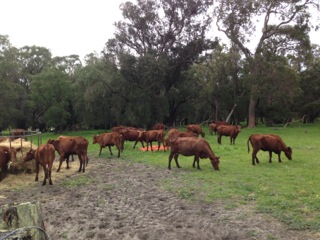 Green grass ensured heads down once they got into the paddock.
Green grass ensured heads down once they got into the paddock.
We have ended up with three poddies that didn’t find mum after the trip that are being raised on the bottle, one ended up with particularly crook guts and has moved up to the big smoke to live with my veterinarian sister for a while for tube feeding and drugs. I’m sure a snowy white shorthorn calf is a normal pet in Hilton!
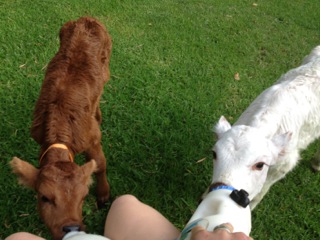 Poddie Calves doing what they do best!
Poddie Calves doing what they do best!
It has not taken long for the cows to settle in to life in the SW, they will spend a while on the home block to ensure they know the ground rules, after a weeks they are now changing paddocks with one person, a dog and an open gate, respectful of single electric wire, and suckers for a tub of reject carrots from the farmers next door. Next step will be preg testing the lot, sending those with calves out to raise them, putting some empty, dry (not pregnant and not feeding a calf) cows onto lush pasture to fatten and picking out the cream of the bunch to schmooze out in the paddock with the Angus bull.
It’s a bit of a gamble and we wont really know hows it gone until a year or so down the track, but all good so far, the cows are not spread all over the south west at least and if the West Australian market and global beef demand strength continues we may have found a way to get ahead a bit. It’s an exciting time to be part of the beef industry, and to finally have some skin in the game makes it all the more thrilling, as well as a little bit terrifying.
A few weeks after arrival the cows go crazy for carrots.

